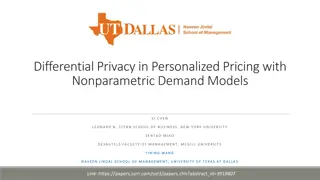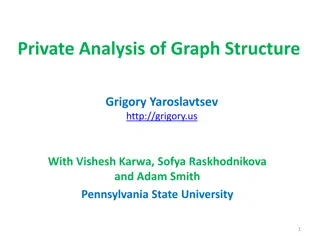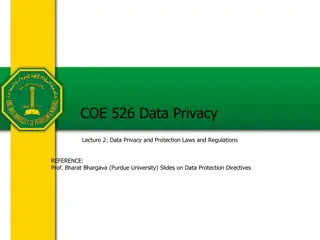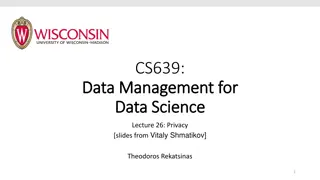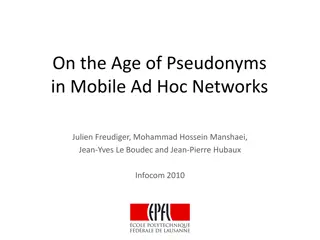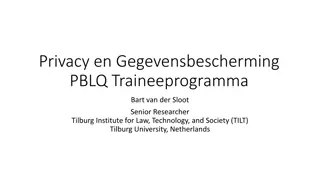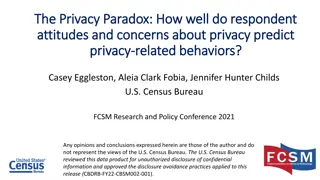Location Privacy Protection using Physical Layer Cooperation
The research presents PhantomPhantom, a system for protecting location privacy by leveraging physical layer cooperation. It explores the challenges of adversary localization systems and proposes solutions such as transmission power and frequency variations. The concept of creating ghost locations and coordination through dummy packet creation is discussed to prevent tracking and localization. Overall, the study aims to enhance privacy protection in location-based systems.
Download Presentation

Please find below an Image/Link to download the presentation.
The content on the website is provided AS IS for your information and personal use only. It may not be sold, licensed, or shared on other websites without obtaining consent from the author.If you encounter any issues during the download, it is possible that the publisher has removed the file from their server.
You are allowed to download the files provided on this website for personal or commercial use, subject to the condition that they are used lawfully. All files are the property of their respective owners.
The content on the website is provided AS IS for your information and personal use only. It may not be sold, licensed, or shared on other websites without obtaining consent from the author.
E N D
Presentation Transcript
Phantom Phantom: Physical Layer Cooperation for Location Privacy Protection Presenter: Tam Vu1 Joint work with Sangho Oh1, Marco Gruteser1, Suman Banerjee2 1WINLAB, Rutgers University 2Department of Computer Sciences, University of Wisconsin 9/6/2024 1
Motivation Adversary Localizing and Tracking System s1 s3 s2 9/6/2024 2
Adversary Localization System Localization algorithm: Radio fingerprinting technique Compare the measured signal vector, r={r1,r2,r3}, with training data measured at each reference point, u(x,y) Select the best matching location for the target user s location AP s2 s1 x 2 1 Eve (Adversary Localization System) . u(1,1) . u(2,1) . . 1 v2 . u(1,2) . . . 2 uA . . . . y Alice . . . . s3 9/6/2024 3
Existing solutions Transmission power variation Transmission frequency variation Adversary Localizing and Tracking System s1 s3 s2 9/6/2024 4
Existing solutions Transmission power variation Transmission frequency variation Directional antennal Adversary Localizing and Tracking System s1 s3 s2 Can we create the same effects without a cumbersome directional antennal ? 9/6/2024 5
Phantom : Ghosts Creation Cloning = With the help of collaborators, transmitters create fake locations with same identity as that of the ones being protected Two synchronized signals from Alice and Bob are combined at adversary sensors Received signal vector , r={r1,r2,r3}, is different from the signal vector from Alice and Bob Challenges Collaborating partners must transmit the exact same bits using the same transmission parameters (e.g. frequency, power, time...) Synchronization Dummy packet creation Pw2 Alice AP Pw1 Eve Pr=Pw1+Pw2 Not Alice Bob (Cooperator) 9/6/2024 6
Coordination and dummy packet creation Backend coordinator Registration, authentication, association, coordination, shared key (kab) distribution Avoid peer-to-peer coordination Explicit coordination may risk the location privacy of nodes Ghost BC IP Cooperation for Cloning kab Dummy packet for A s ghost Message Payload Source Address A (Transmitter) B (Cooperator) Alice A A 01101 10101 i A 10101 Beacon from AP Bob 7
Phantom Experiments Demonstrate creating clones of nodes by cooperative transmission Use software defined radios (GNU Radios) Transmit 802.11g packets Show the RSS change in adversary sensors due to cooperative transmission 9/6/2024 8
Frequency Synchronization Frequency synchronization Manual configuration Reduce ICI between the two signals Before Manual calibration After 9/6/2024 9
Time Synchronization Time synchronization Coarse: Use GPS in outdoors: ~500nsec cheap GPS modules Indoors: Use beacon from AP Fine time offset ( off ) adjustment Caused by imperfect local oscillator Measured by correlating the received signal with preamble (known signal pattern) Fine Time offset adjustment Before After 9/6/2024 10
Cloning Experiments: Results (2) After time/frequency synchronization Pass the integrity check of the adversary Measured RSS is the sum of two received signal power 9/6/2024 11
ORBIT Experiment: Location privacy protection performance measure Experiment setup: ORBIT Transmitter and cooperator 2 GNU Radios Adversary Nodes in ORBIT Grid Cooperation power control Change the location of the clone Power configuration Tx-1 power = k [dBm] Tx-2 power = 20-k [dBm] 9/6/2024 12
Conclusion Phantom enables users to dynamically create confusion about their location by creating additional ghost transmission from different locations with the same identity We implemented a proof of concept using software defined radios as transmitters and explored issues related to frequency and time synchronization of such transmitters. We demonstrated the feasibility of inducing localization errors through cooperative transmissions. 9/6/2024 13


